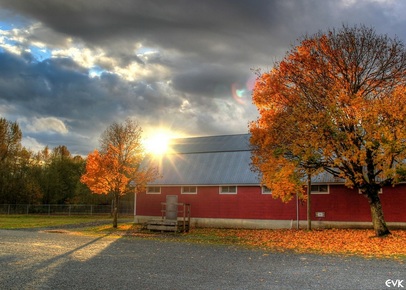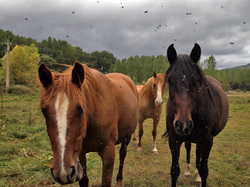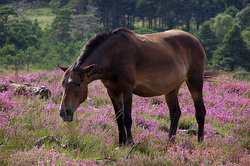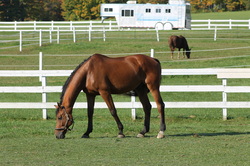
With fall upon us, there are some important things that you'll want to make sure you get done around the barn before the snow flies. Add these items to your fall to-do list around the barn.
Check Fire Extinguishers and Smoke Detectors
Now is the time to make sure that your fire extinguishers haven't expired, and that they're placed appropriately throughout the barn. Be sure to check your smoke detectors, too, and replace the batteries if you didn't already do so in the spring.
Clean Out the Feed Room
During the busy summer it's easy to let cleaning slip. Before you stock up on feed for the winter, thoroughly clean out the feed room. Keep an eye out for signs of rodents, and check all of the feed for spoilage. Don't forget to check the expiration dates of feed and supplements.
Stock Up On Hay
You don't want to have to deal with a hay delivery when the roads are snowy and ice-covered, so be sure to stock up on hay now. Check your remaining hay for mold, and make sure to store all of the hay properly to lessen the risk of fire.
Check Your Horse's Weight
Before you start blanketing your horse for winter, it's a good idea to check and record his weight. Knowing his starting weight will help you monitor him through the winter to make sure that he doesn't gain or lose too much.
Decobweb
Choose a day when the horses are outside, and go through to thoroughly decobweb the barn. Perform a thorough sweeping while you're at it, and take the time to thoroughly scrub out both feed and water buckets.
Update Contact Information
Your fall barn cleaning is the perfect time to update all contact information that you have at the barn. Make sure that all of your phone numbers on your horse's emergency contact cards are current and accurate so that you can be reached in an emergency.
Evaluate Your Horse's Feed Schedule
As the days become colder, many horses receive less exercise. Now is the time to evaluate your horse's feed plan and begin to make adjustments for the winter. Remember that your horse should receive plenty of roughage, and you may need to decrease his grain as his workload lessens.
Schedule Your Horse's Fall Vaccines
In many areas of the country, giving your horse fall shots is recommended to booster his defenses against diseases. Talk with your vet about whether your horse might need fall shots, and make an appointment if you decide to have him receive the shots.
Check Blanket Fit
As you dig out your horse's blankets from last year, take the time to check and make sure that they fit your horse before you depend on them. You'll also want to look for any repairs that the blankets might need.
Clean Your Tack
Tack gets rigorous use during the summer. Schedule some time to sit down and give your tack a thorough cleaning and conditioning. Look for any signs of weakness or breakage. If you find issues, have your tack professionally repaired before using it again.
Winter will be here soon. It's important to get these barn chores done in the fall so that you're ready for the cold when it comes.
Photo source: http://pixabay.com/en/barn-red-sunset-clouds-campbell-63835/
Check Fire Extinguishers and Smoke Detectors
Now is the time to make sure that your fire extinguishers haven't expired, and that they're placed appropriately throughout the barn. Be sure to check your smoke detectors, too, and replace the batteries if you didn't already do so in the spring.
Clean Out the Feed Room
During the busy summer it's easy to let cleaning slip. Before you stock up on feed for the winter, thoroughly clean out the feed room. Keep an eye out for signs of rodents, and check all of the feed for spoilage. Don't forget to check the expiration dates of feed and supplements.
Stock Up On Hay
You don't want to have to deal with a hay delivery when the roads are snowy and ice-covered, so be sure to stock up on hay now. Check your remaining hay for mold, and make sure to store all of the hay properly to lessen the risk of fire.
Check Your Horse's Weight
Before you start blanketing your horse for winter, it's a good idea to check and record his weight. Knowing his starting weight will help you monitor him through the winter to make sure that he doesn't gain or lose too much.
Decobweb
Choose a day when the horses are outside, and go through to thoroughly decobweb the barn. Perform a thorough sweeping while you're at it, and take the time to thoroughly scrub out both feed and water buckets.
Update Contact Information
Your fall barn cleaning is the perfect time to update all contact information that you have at the barn. Make sure that all of your phone numbers on your horse's emergency contact cards are current and accurate so that you can be reached in an emergency.
Evaluate Your Horse's Feed Schedule
As the days become colder, many horses receive less exercise. Now is the time to evaluate your horse's feed plan and begin to make adjustments for the winter. Remember that your horse should receive plenty of roughage, and you may need to decrease his grain as his workload lessens.
Schedule Your Horse's Fall Vaccines
In many areas of the country, giving your horse fall shots is recommended to booster his defenses against diseases. Talk with your vet about whether your horse might need fall shots, and make an appointment if you decide to have him receive the shots.
Check Blanket Fit
As you dig out your horse's blankets from last year, take the time to check and make sure that they fit your horse before you depend on them. You'll also want to look for any repairs that the blankets might need.
Clean Your Tack
Tack gets rigorous use during the summer. Schedule some time to sit down and give your tack a thorough cleaning and conditioning. Look for any signs of weakness or breakage. If you find issues, have your tack professionally repaired before using it again.
Winter will be here soon. It's important to get these barn chores done in the fall so that you're ready for the cold when it comes.
Photo source: http://pixabay.com/en/barn-red-sunset-clouds-campbell-63835/



 RSS Feed
RSS Feed
